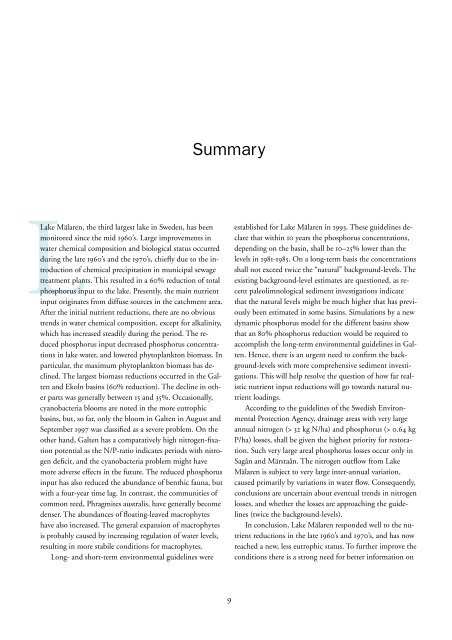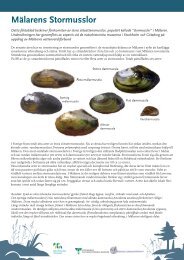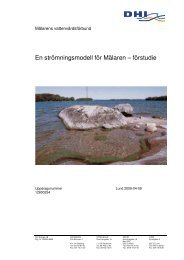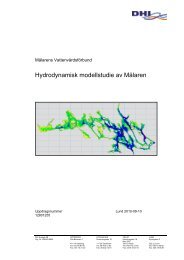miljötillstånd och utveckling - Mälarens vattenvårdsförbund
miljötillstånd och utveckling - Mälarens vattenvårdsförbund
miljötillstånd och utveckling - Mälarens vattenvårdsförbund
You also want an ePaper? Increase the reach of your titles
YUMPU automatically turns print PDFs into web optimized ePapers that Google loves.
Lake Mälaren, the third largest lake in Sweden, has been<br />
monitored since the mid 1960’s. Large improvements in<br />
water chemical composition and biological status occurred<br />
during the late 1960’s and the 1970’s, chiefly due to the introduction<br />
of chemical precipitation in municipal sewage<br />
treatment plants. This resulted in a 60% reduction of total<br />
phosphorus input to the lake. Presently, the main nutrient<br />
input originates from diffuse sources in the catchment area.<br />
After the initial nutrient reductions, there are no obvious<br />
trends in water chemical composition, except for alkalinity,<br />
which has increased steadily during the period. The reduced<br />
phosphorus input decreased phosphorus concentrations<br />
in lake water, and lowered phytoplankton biomass. In<br />
particular, the maximum phytoplankton biomass has declined.<br />
The largest biomass reductions occurred in the Galten<br />
and Ekoln basins (60% reduction). The decline in other<br />
parts was generally between 15 and 35%. Occasionally,<br />
cyanobacteria blooms are noted in the more eutrophic<br />
basins, but, so far, only the bloom in Galten in August and<br />
September 1997 was classified as a severe problem. On the<br />
other hand, Galten has a comparatively high nitrogen-fixation<br />
potential as the N/P-ratio indicates periods with nitrogen<br />
deficit, and the cyanobacteria problem might have<br />
more adverse effects in the future. The reduced phosphorus<br />
input has also reduced the abundance of benthic fauna, but<br />
with a four-year time lag. In contrast, the communities of<br />
common reed, Phragmites australis, have generally become<br />
denser. The abundances of floating-leaved macrophytes<br />
have also increased. The general expansion of macrophytes<br />
is probably caused by increasing regulation of water levels,<br />
resulting in more stabile conditions for macrophytes.<br />
Long- and short-term environmental guidelines were<br />
Summary<br />
9<br />
established for Lake Mälaren in 1993. These guidelines declare<br />
that within 10 years the phosphorus concentrations,<br />
depending on the basin, shall be 10–25% lower than the<br />
levels in 1981-1985. On a long-term basis the concentrations<br />
shall not exceed twice the “natural” background-levels. The<br />
existing background-level estimates are questioned, as recent<br />
paleolimnological sediment investigations indicate<br />
that the natural levels might be much higher that has previously<br />
been estimated in some basins. Simulations by a new<br />
dynamic phosphorus model for the different basins show<br />
that an 80% phosphorus reduction would be required to<br />
accomplish the long-term environmental guidelines in Galten.<br />
Hence, there is an urgent need to confirm the background-levels<br />
with more comprehensive sediment investigations.<br />
This will help resolve the question of how far realistic<br />
nutrient input reductions will go towards natural nutrient<br />
loadings.<br />
According to the guidelines of the Swedish Environmental<br />
Protection Agency, drainage areas with very large<br />
annual nitrogen (> 32 kg N/ha) and phosphorus (> 0.64 kg<br />
P/ha) losses, shall be given the highest priority for restoration.<br />
Such very large areal phosphorus losses occur only in<br />
Sagån and Märstaån. The nitrogen outflow from Lake<br />
Mälaren is subject to very large inter-annual variation,<br />
caused primarily by variations in water flow. Consequently,<br />
conclusions are uncertain about eventual trends in nitrogen<br />
losses, and whether the losses are approaching the guidelines<br />
(twice the background-levels).<br />
In conclusion, Lake Mälaren responded well to the nutrient<br />
reductions in the late 1960’s and 1970’s, and has now<br />
reached a new, less eutrophic status. To further improve the<br />
conditions there is a strong need for better information on






